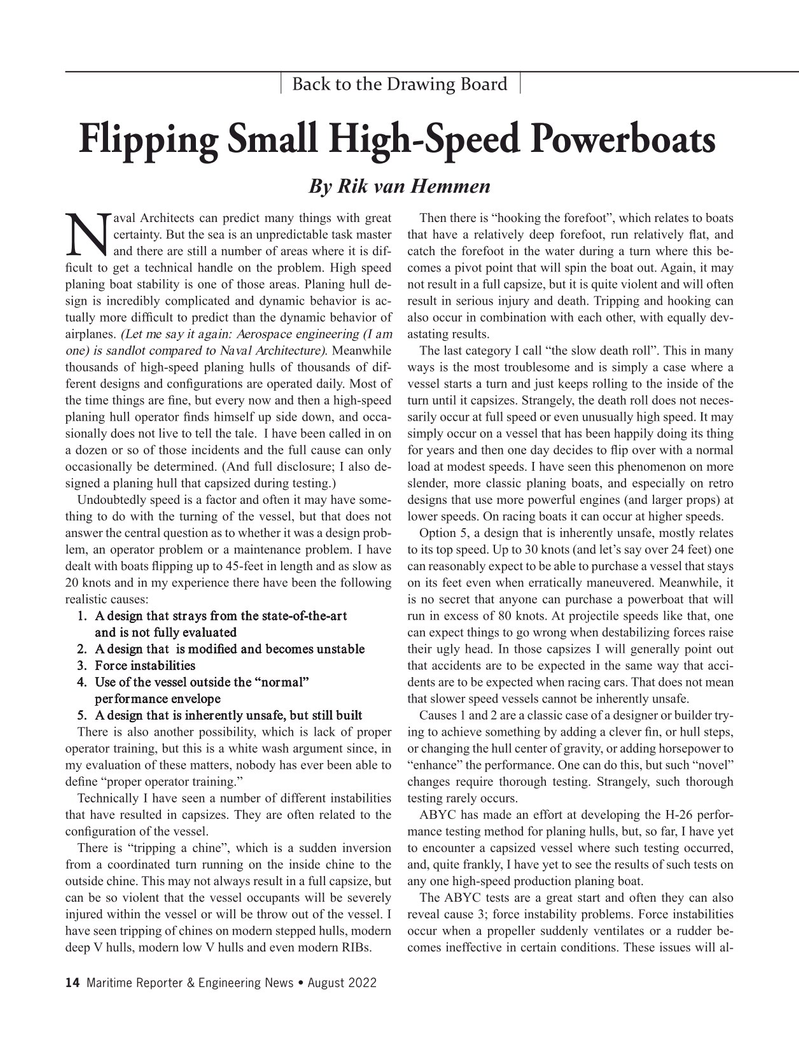
Page 14: of Maritime Reporter Magazine (August 2022)
The Shipyard Annual
Read this page in Pdf, Flash or Html5 edition of August 2022 Maritime Reporter Magazine
Back to the Drawing Board
Flipping Small High-Speed Powerboats
By Rik van Hemmen aval Architects can predict many things with great Then there is “hooking the forefoot”, which relates to boats certainty. But the sea is an unpredictable task master that have a relatively deep forefoot, run relatively ? at, and
Nand there are still a number of areas where it is dif- catch the forefoot in the water during a turn where this be- ? cult to get a technical handle on the problem. High speed comes a pivot point that will spin the boat out. Again, it may planing boat stability is one of those areas. Planing hull de- not result in a full capsize, but it is quite violent and will often sign is incredibly complicated and dynamic behavior is ac- result in serious injury and death. Tripping and hooking can tually more dif? cult to predict than the dynamic behavior of also occur in combination with each other, with equally dev- airplanes. (Let me say it again: Aerospace engineering (I am astating results. one) is sandlot compared to Naval Architecture). Meanwhile The last category I call “the slow death roll”. This in many thousands of high-speed planing hulls of thousands of dif- ways is the most troublesome and is simply a case where a ferent designs and con? gurations are operated daily. Most of vessel starts a turn and just keeps rolling to the inside of the the time things are ? ne, but every now and then a high-speed turn until it capsizes. Strangely, the death roll does not neces- planing hull operator ? nds himself up side down, and occa- sarily occur at full speed or even unusually high speed. It may sionally does not live to tell the tale. I have been called in on simply occur on a vessel that has been happily doing its thing a dozen or so of those incidents and the full cause can only for years and then one day decides to ? ip over with a normal occasionally be determined. (And full disclosure; I also de- load at modest speeds. I have seen this phenomenon on more signed a planing hull that capsized during testing.) slender, more classic planing boats, and especially on retro
Undoubtedly speed is a factor and often it may have some- designs that use more powerful engines (and larger props) at thing to do with the turning of the vessel, but that does not lower speeds. On racing boats it can occur at higher speeds.
answer the central question as to whether it was a design prob- Option 5, a design that is inherently unsafe, mostly relates lem, an operator problem or a maintenance problem. I have to its top speed. Up to 30 knots (and let’s say over 24 feet) one dealt with boats ? ipping up to 45-feet in length and as slow as can reasonably expect to be able to purchase a vessel that stays 20 knots and in my experience there have been the following on its feet even when erratically maneuvered. Meanwhile, it realistic causes: is no secret that anyone can purchase a powerboat that will 1. A design that strays from the state-of-the-art run in excess of 80 knots. At projectile speeds like that, one and is not fully evaluated can expect things to go wrong when destabilizing forces raise 2. A design that is modi? ed and becomes unstable their ugly head. In those capsizes I will generally point out 3. Force instabilities that accidents are to be expected in the same way that acci- 4. Use of the vessel outside the “normal” dents are to be expected when racing cars. That does not mean performance envelope that slower speed vessels cannot be inherently unsafe. 5. A design that is inherently unsafe, but still built Causes 1 and 2 are a classic case of a designer or builder try-
There is also another possibility, which is lack of proper ing to achieve something by adding a clever ? n, or hull steps, operator training, but this is a white wash argument since, in or changing the hull center of gravity, or adding horsepower to my evaluation of these matters, nobody has ever been able to “enhance” the performance. One can do this, but such “novel” de? ne “proper operator training.” changes require thorough testing. Strangely, such thorough
Technically I have seen a number of different instabilities testing rarely occurs. that have resulted in capsizes. They are often related to the ABYC has made an effort at developing the H-26 perfor- con? guration of the vessel. mance testing method for planing hulls, but, so far, I have yet
There is “tripping a chine”, which is a sudden inversion to encounter a capsized vessel where such testing occurred, from a coordinated turn running on the inside chine to the and, quite frankly, I have yet to see the results of such tests on outside chine. This may not always result in a full capsize, but any one high-speed production planing boat.
can be so violent that the vessel occupants will be severely The ABYC tests are a great start and often they can also injured within the vessel or will be throw out of the vessel. I reveal cause 3; force instability problems. Force instabilities have seen tripping of chines on modern stepped hulls, modern occur when a propeller suddenly ventilates or a rudder be- deep V hulls, modern low V hulls and even modern RIBs. comes ineffective in certain conditions. These issues will al- 14 Maritime Reporter & Engineering News • August 2022
MR #8 (1-17).indd 14 8/4/2022 10:54:10 AM

 13
13

 15
15
